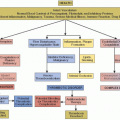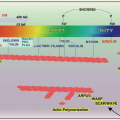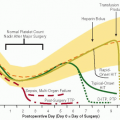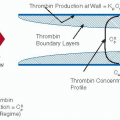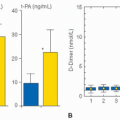Blood-borne microparticles are highly heterogeneous with respect to their size and composition, in addition to their cellular sources.
13 By definition, their sizes span a range of diameters that varies by a factor of 10, from 0.1 to 1 µm. If the shape of a microparticle is assumed to be spherical, this size range translates to a 100-fold difference in surface area and a 1,000-fold difference in volume between the smallest and largest microparticles.
In addition to heterogeneity in size, their cellular sources are extremely varied. In the most common order of abundance
in human blood: platelets, megakaryocytes, endothelial cells, erythrocytes, lymphocytes, monocytes, vascular smooth muscle cells, dendritic cells, and, often, tumor cells.
Platelet and Megakaryocyte Microparticles
The existence of platelet microparticles was first inferred by Chargaff and West
17 in 1946, when they noted that there was a precipitable factor in plasma capable of supporting thrombin generation. In 1967, Wolf
18 described the source of this procoagulant activity as being the platelet and also identified the microparticles morphologically. He termed them “platelet dust.” Wolf also demonstrated that there was a linear relationship between the number of platelets and the quantity of microparticles in the blood, with thrombocytopenic patients having low numbers of microparticles compared to normals and those with polycythemia vera having elevated microparticle numbers.
Microparticles containing platelet markers account for 70% to 90% of circulating microparticles in healthy individuals.
19,20,21 Markers used to identify these microparticles by antibody staining and flow cytometry include CD41(the α subunit of the integrin α
IIbβ
3), CD42b (glycoprotein [GP] Ibα), CD42a (GPIX), CD61 (the β subunit of the integrin α
IIbβ
3), and CD62P (P-selectin).
13 Controversy exists over the extent to which platelet microparticles express PS, with some studies using the binding of annexin V as one of the defining characteristics of these microparticles
22 and one study finding that up to 80% of microparticles staining with platelet markers did not express PS.
23 This point is an important one, as some methods of microparticle quantification rely on annexin V capture of the microparticles
15 or base their definition of microparticles on the ability to bind annexin V. Despite these concerns, isolation by annexin V capture likely does give a reasonable estimate of the procoagulant capacity of the microparticles.
24Various stimuli are capable of eliciting microparticles from platelets, including thrombin, collagen, complement C5b-9,
high shear stress, and calcium ionophore.
25,26,27,28,29,30,31,32,33,34,35 Microparticle generation is coupled to externalization of PS on the platelet membrane and is a key component of the ability of platelets to support the enzymatic reactions of the coagulation system that eventuate in thrombin production and formation of insoluble fibrin clots.
Platelets also generate microparticles as they undergo apoptosis, albeit of a different nature than the microparticles produced by agonist stimulation.
36,37,38,39Numerous studies have reported elevated platelet microparticle concentrations in association with a variety of pathologic conditions, including acute coronary syndromes, atherosclerosis, hypertension, diabetes, venous thromboembolism, heparin-induced thrombocytopenia, antiphospholipid syndrome, thrombotic thrombocytopenic purpura, sickle cell disease, human immunodeficiency virus (HIV) infection, sepsis, malignancies, and several other conditions (
Table 36.2).
Although it was initially believed that microparticle staining with platelet markers arose entirely from platelets, recent evidence by Flaumenhaft et al.
40 call this interpretation into question. Using videomicroscopy, these investigators demonstrated the capacity of cultured mouse megakaryocytes to vesiculate, the vesicles arising along the lengths of micropodia. These microparticles expressed CD41, CD42b, and PS. However, they were distinct from platelet microparticles in that they failed to express CD62P and LAMP-1 and they contained uncleaved filamin A, whereas filamin A found in platelet microparticles was uniformly proteolyzed to smaller fragments. In the blood of mice and healthy human volunteers, most of the “platelet” microparticles detected by these investigators did not express CD62P and LAMP-1, leading them to conclude that the microparticles were derived from megakaryocytes. Because both CD62P and LAMP-1 are membrane proteins restricted to granule membranes in unactivated platelets, this finding could also indicate that, in addition to a megakaryocyte source for these particles, they might also arise normally
in vivo from platelets that have not been stimulated to release granules.
Endothelium
A second major source of microparticles in the blood is the endothelium. These microparticles arise by blebbing of the endothelial plasma membrane,
41 and they carry a wide variety of endothelial membrane proteins, including CD54 (ICAM-1), CD62E (E-selectin), CD31 (PECAM), CD105 (endoglin), CD144 (VE-cadherin), and CD146 (MUC1).
6 Because platelet microparticles also express CD31, endothelial cell microparticles are distinguishable by the absence of CD41 staining. A wide variety of stimuli have been reported to induce microparticle production by endothelium, including tumor necrosis factor (TNF)-α, interleukin-1, uremic toxins, oxidized low-density lipoproteins, oxidants such as superoxide and hypochlorous acid, and agents that uncouple nitric oxide synthase.
42,43,44,45,46 Endothelial cells undergoing apoptosis also elaborate microparticles. Microparticles released by cells undergoing apoptosis express more CD31 and less CD62E than those elaborated by cells exposed to activation stimuli.
47Endothelial microparticles are elevated in a number of conditions, all of which involve endothelial pathology. These include acute coronary syndromes, hypertension, metabolic syndrome, diabetes, chronic renal failure, systemic lupus erythematosus, sickle cell disease, pulmonary artery hypertension, malaria, and others (
Table 36.2).
Erythrocytes
Erythrocyte microparticles make up only a small fraction of microparticles in the blood of normal individuals,
19 but their quantity can be increased considerably in a number of disorders that primarily affect the erythrocyte and other systemic disorders. Hemolytic anemias, both hereditary and acquired, are associated with increased blood microparticle levels, including paroxysmal nocturnal hemoglobinuria,
48 sickle cell disease,
49,50,51 the thalassemias,
52,53,54 autoimmune hemolytic anemia, malaria,
55,56 and disorders of the erythrocyte membrane skeleton.
57,58 Erythrocyte microparticle levels are also often elevated in systemic disorders such as atherosclerosis and chronic renal failure.
59,60In addition to conditions that increase erythrocyte microparticles
in vivo, microparticles are also produced during extended red cell storage and by conditions that can affect the stored red cells, such as ATP depletion or low pH.
58,61,62,63,64 Exposure to agents that elevate intracellular calcium concentrations, such as the calcium ionophore A23187, also induces erythrocytes to produce microparticles. Erythrocyte microparticles are usually identified by staining for glycophorin A (CD235a).
54,65
Leukocyte Microparticles
Monocytes, neutrophils, and lymphocytes all produce microparticles.
65 Those derived from monocytes or tissue macrophages are identified by surface expression of CD14 and often are extremely procoagulant by virtue of carrying tissue factor (TF) in addition to expressing anionic phospholipids.
66 Neutrophils and lymphocytes also shed microparticles. Neutrophil microparticles are elevated in a number of inflammatory states known to be associated with neutrophil activation, including acute vasculitis, preeclampsia, rheumatoid arthritis, and meningitis.
67,68,69,70,71,72 Elevated neutrophil microparticle counts have also been reported in patients with extensive atherosclerosis and in those undergoing hemodialysis.
60,68Like monocytes, neutrophils have been reported to elaborate TF-bearing microparticles in response to activation with the anaphylatoxin C5a,
73,74,75 although this property might also be a consequence of fusion of TF-bearing microparticles with neutrophils, not from actual TF synthesis by the neutrophils themselves.
76 



